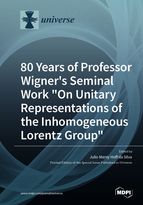80 Years of Professor Wigner's Seminal Work "On Unitary Representations of the Inhomogeneous Lorentz Group"
A special issue of Universe (ISSN 2218-1997). This special issue belongs to the section "Field Theory".
Deadline for manuscript submissions: closed (31 May 2021) | Viewed by 17758
Special Issue Editor
Special Issue Information
Dear Colleagues,
The present Special Issue is dedicated to celebrate the 80 years of the Professor Eugene P. Wigner paper “On Unitary Representations of the Inhomogeneous Lorentz Group", published in The Annals of Mathematics in 1939. Over 56 pages, the representation of the Poincaré group in the Hilbert space is rigorously constructed step by step, relating spacetime symmetries with the concept of symmetry in Quantum Mechanics. As a result, the very concept of asymptotic one particle states is presented, enhancing the role of symmetry in the foundations of Physics.
The impact of Professor Wigner’s work can hardly be overestimated. The spacetime symmetries, represented in the Hilbert space, could then related to the internal symmetries; the symmetries organizing interactions to be supported, or mediated, by the particle states resulting from the representation procedure. The quantum and the relativistic worlds were bound.
This volume shall contemplate topics from general aspects, going through history and philosophy, to mathematical and physical issues related to the impact of symmetries groups in the foundations of relativistic quantum physics.
Dr. Julio Marny Hoff da Silva
Guest Editor
Manuscript Submission Information
Manuscripts should be submitted online at www.mdpi.com by registering and logging in to this website. Once you are registered, click here to go to the submission form. Manuscripts can be submitted until the deadline. All submissions that pass pre-check are peer-reviewed. Accepted papers will be published continuously in the journal (as soon as accepted) and will be listed together on the special issue website. Research articles, review articles as well as short communications are invited. For planned papers, a title and short abstract (about 100 words) can be sent to the Editorial Office for announcement on this website.
Submitted manuscripts should not have been published previously, nor be under consideration for publication elsewhere (except conference proceedings papers). All manuscripts are thoroughly refereed through a single-blind peer-review process. A guide for authors and other relevant information for submission of manuscripts is available on the Instructions for Authors page. Universe is an international peer-reviewed open access monthly journal published by MDPI.
Please visit the Instructions for Authors page before submitting a manuscript. Submitted papers should be well formatted and use good English. Authors may use MDPI's English editing service prior to publication or during author revisions.
Keywords
- group representation
- symmetries in physics
- mathematical aspects of quantum mechanics and quantum field theory
Benefits of Publishing in a Special Issue
- Ease of navigation: Grouping papers by topic helps scholars navigate broad scope journals more efficiently.
- Greater discoverability: Special Issues support the reach and impact of scientific research. Articles in Special Issues are more discoverable and cited more frequently.
- Expansion of research network: Special Issues facilitate connections among authors, fostering scientific collaborations.
- External promotion: Articles in Special Issues are often promoted through the journal's social media, increasing their visibility.
- e-Book format: Special Issues with more than 10 articles can be published as dedicated e-books, ensuring wide and rapid dissemination.
Further information on MDPI's Special Issue polices can be found here.






